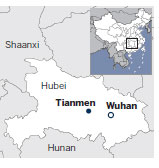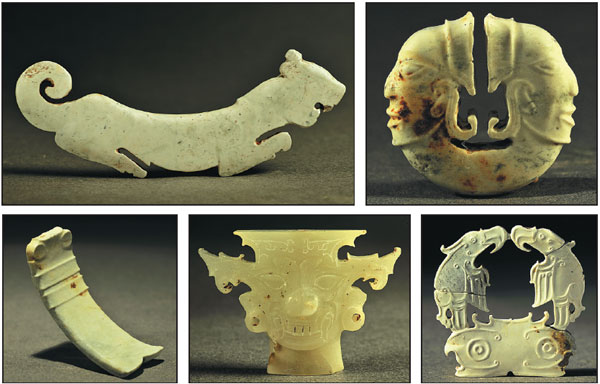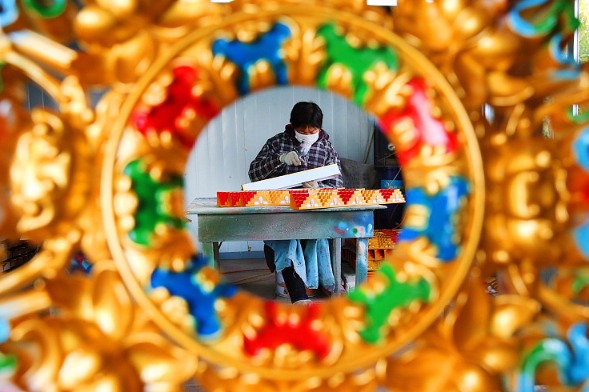Green mysteries
No stone evokes China like jade. Lately, 4,000-year-old pieces found in Hubei province are shedding new light on an ancient industry, report Lei Xiaoxun in Beijing, and Zhou Lihua and Liu Kun in Wuhan.
Some of the figurines are human, some are animal. All are believed to be symbols of spirits, perhaps of ancestors. The luminous animals may represent magical, mythic creatures prevalent in the ancient times, when people believed spirits had a supernatural power to communicate between Earth and heaven.
Today the figures, unearthed in November in Central China, are communicating a different story: Leading experts from both the Chinese mainland and Taiwan believe the discovery of a large amount of jadeware at a late Neolithic burial site in November are a missing link, a key to prove that jade culture in the Shang Dynasty (c. 16th century-11th century BC) was profoundly influenced and may have been inherited from the late Neolithic jade culture in the midstream region of the Yangtze River.
Unlike previous Shijiahe jades excavated nearby - which are simple in design and crafting - the pieces found last year, about 240 in total, represent what is likely the highest level of jade art in China or even eastern Asia, according to Fang Qin, director of the Hubei Provincial Archaeological Research Institution.
Fang, also the curator of Hubei Provincial Museum, says the newfound jades are far finer and more delicate than previously discovered.
"For instance, there is only a half-tiger sculpture among the jades we found before," he says, "but there is an intact tiger figurine this time".
The sophisticated jade carvings and sculptures dating back to about 4,000 years ago, were excavated in Tianmen county, Hubei province. Previous archaeological research and excavations there have determined that the pieces were made in the late Shijiahe Culture (2,500 BC-2,000 BC) period, a late Neolithic culture that succeeded the Qujialing Culture (3,400 BC-2,600 BC) in the same region with rare artifact and design of painted spindle whorls.
Pristine figurines made with pottery and jades crafted with the locally produced gems and distinctive techniques were particular to the Shijiahe Culture, notably the way sculpted lines remain attached to but are slightly raised against the background of jade material.
The relief technique requires time-consuming chiseling of the background. The discoveries include an openwork plaque with two birds standing on an animal face and a double-headed figurine with the typical relief design, says Wu Tarng-hae, a senior researcher at the Shanghai-based Aurora Museum.
Wu, a prestigious Taiwan expert in ancient Chinese art, especially jade research, says the relief line pattern of Shijiahe jadeware is achieved by consecutive scraping or wearing down the jade surface background between parallel carved lines.
Rubbing and polishing then make the line slightly raised on the jade surface, creating a three-dimensional effect when the jade surface is viewed at different angles and lighting conditions.
China's age-old jade tradition is characterized by many innovations in different cultures and dynasties.
Over China's long history, such as in the mid-Neolithic period between 7,000 and 8,000 years ago, people living in the country's northeast had already developed the custom of carving the pretty stones into special tools or jewelry.
By about 4,000 BC, jade-making reached its first peak in the late Neolithic period. Four major, regionally based jadeware production hubs gradually came into existence: the Hongshan Culture in the northeast, the Liangzhu Culture in the east and lower reaches of the Yangtze River, the Longshan Culture (now Shandong province) and the Qijia Culture in Northwest China.
"Jadeware of the Shang Dynasty was greatly influenced by Shijiahe jadeware", says Ding Zhe, president of the Chinese Society of Ancient Jade, a Beijing-based NGO.
"The relief lines and the way that Shijiahe jade carvers engraved animal and human eyes in the Shang Dynasty can trace their origins back to the Shijiahe Culture," he adds. Most of the Shijiahe pieces are made from nephrite, a silicate mineral that is greenish white in color with a glasslike shiny surface.
Eyes of both Shijiahe jades and Shang jades are carved in the similar shape of Chinese character chen (minister of a monarch).
Some of the jadeware shapes of Shijiahe, such as the cicada or openwork plaque mimicking a long (Chinese dragon) or a human head, were inherited in the Shang and later dynasties.
"Although Hongshan Culture jades and Liangzhu Culture jades are undoubtedly prominent representatives of Neolithic ancient Chinese jades, the two cultures died and vanished after peaking in their own times", says the Aurora Museum's Wu.
"Shijiahe jade is still the most important origin of ancient Chinese jades," he says, adding that much more splendid and exquisite Shijiahe jades are expected to be unearthed in future excavations, because the current collections have been found from low or middle-level urn-burial sites.
"Surprises will arise from those large-scale tomb sites," he says.
While archaeological and research work is ongoing in the Tianmen county area, museum officials say the recently unearthed jades will be on public display later this year or the next.
Contact the writers through leixiaoxun@chinadaily.com.cn

CLOSE LOOK
Before the November discovery of about 240 fine jade objects, a total of 406 such gems had been unearthed from the sites of Shijiahe. The objects include human figurines, human head, cicada, long (Chinese dragon)-shaped ornaments, bird-shaped ornaments, bi (disk), tube-shaped ornaments, rings, hairpins and tiger head.
Analysis of the Shijiahe jades shows that most are made from nephrite, a silicate mineral that is greenish white in color with a glasslike shiny surface and a hardness of about 5.5 on the Mohs hardness scale of 10. Other Shijiahe jades are carved from chalcedonite, crystal, steatite, quartz or turquoise.
Some of the jades might have been badges or accessories sewn on clothing, while others drilled with holes could have served as jewelry. Similar jade figures had also been unearthed in the remains of the Shang and Zhou dynasties. All these figures share some significant similarities such as the shape of design and relief lines on the surface.
| Jadeware, excavated in November from Tianmen county, Hubei province, include (clockwise from top left) a tiger, double-head figurine, two birds, human head and curved cicada.Photos Provided To China Daily By Shijiahe Relics Archaeological Team Of Hubei Provincial Archaeological Research Institution |
(China Daily USA 01/19/2016 page7)



















